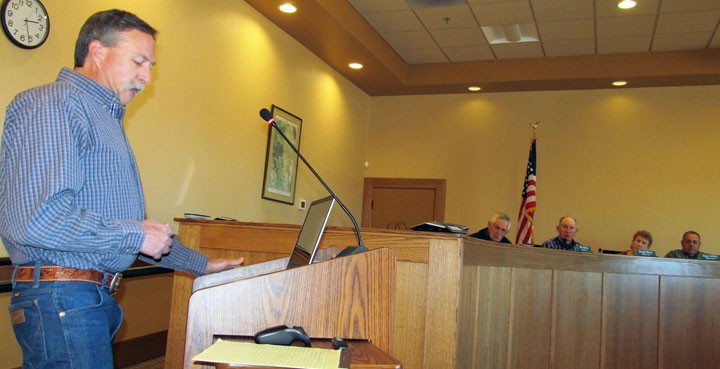Basin outlook optimistic as dismal year ends

ALAMOSA — Concluding a year that rivaled the drought year of 2002, early mountain snows provide some hope of a better runoff in 2019.
Craig Cotten, Colorado Division of Water Resources division engineer for Division 3, recapped the irrigation season and gave a preview of what might be in store this winter during a presentation on Tuesday to the Rio Grande Water Conservation District board.
“We are at 1,600 percent of normal right now,” he said about the very early snowpack. He said although the Rio Grande Basin has not received a lot of snow yet, it arrived earlier than usual. In the historic drought year of 2002 the basin did not have the snow it has now until well into December.
“Hopefully we can continue with that,” Cotten said, “and have a good year.”
The snowpack earlier this year was barely above 2002 levels, he said, and significantly below average. Stream flows in some areas were even lower than 2002, he added.
Production on the Rio Grande at Del Norte will be 280,000 acre feet for the year, or about 43 percent of the long-term average of about 650,000 acre feet, according to Cotten. Of that, the basin owes 71,000 acre feet to downstream states to meet its Rio Grande Compact obligations. Cotten said although the basin still owes some of that, it would have no problem meeting that obligation during the winter months.
“We calculate we will get 100 percent of the water through the system down to the downstream states,” he said.
The division did not have to curtail water users during the irrigation season to meet that obligation and in fact will wind up with a credit with the downstream states, Cotten added. If the division ends the irrigation season at its prescribed time, November 1, Colorado will probably end the year having over-delivered about 13,000 acre feet to the downstream states, Cotten explained.
Because he would rather not send that much water downstream, he is considering extending the irrigation season past November 1 and/or going to recharge, he added. Some ditches on the Rio Grande have recharge decrees during the winter and can use water to recharge the aquifer in the closed basin area.
Cotten said Colorado can go into a credit status under the compact provisions, but that credit water would be stored in New Mexico’s Elephant Butte Reservoir, which is experiencing significant evaporation. Currently the Elephant Butte Reservoir, which has the capacity to hold two million acre-feet, has about 60,000 acre-feet of water in it. “So there’s not a lot of water there,” Cotten said.
“We are going to end up with a lot of evaporation,” Cotten said. “We are definitely trying to look at ways to decrease that credit down there.”
Another concern about such a large amount of credit water, he said, is that there has been some contention in the past about whose credit water that was. That occurred in 2011, for example, when the Bureau of Reclamation maintained that water Colorado considered as credit water belonged to Texas. “We don’t want to get into that situation again,” Cotten said.
In addition to the 13,000 acre feet of credit water expected to accrue on the Rio Grande this year, the basin could accumulate about 4,000 acre feet of credit water on the Conejos River system. Cotten said the Conejos actually had a better flow this year than the Rio Grande — “but still a very bad year” — with 51 percent of the long-term average or about 160,000 acre feet, of which 25,000 acre feet is owed downstream. As with the Rio Grande, there was no curtailment of water users during the irrigation season.
With about 4,000 acre-feet of credit water on the Conejos River system, Cotten is looking at ways to keep from sending it all downriver.
Extending the irrigation season past November 1 could be a problem, however, because the lower end of the Conejos River is dry and has been for quite a while, he said, so trying to get water through the system to get it wet again would take some time, and cold weather could cause problems with icing up the river.
Cotten said that the National Weather Service is predicting above average precipitation for southern Colorado for November, December and January. “We are kind of on the border … on the edge of the above average precipitation,” Cotten said.
However, the National Weather Service is also calling for above average temperatures for this region during that time as well, he added.
“We are in that warmer than average area throughout most of the west U.S.,” he said.



